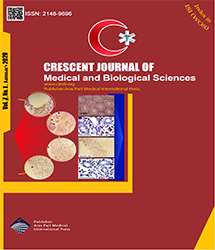| Original Article | |
| Epidemiology and Identifcation of Actin Gene of Trichomonas vaginalis Genotypes in Women of Southeast of Iran Using PCR-RFLP | |
| Fateme Shahraki1, Bahman Fouladi2, Alireza Salimi-Khorashad3, Nahid Sepehri-Rad3, Mansour Dabirzadeh 1 | |
| 1Department of Parasitology, Faculty of Medical Sciences, Zabol University of Medical Sciences, Zabol, Iran 2Department of Parasitology and Mycology, Faculty of Medical Sciences, Zabol University of Medical Sciences, Zabol, Iran 3Infectious Diseases and Tropical Medicine Research Center, Zahedan University of Medical Sciences, Zahedan, Iran |
|
|
CJMB 2020; 7: 82–90 Viewed : 5495 times Downloaded : 3294 times. Keywords : Trichomonas vaginalis, Actin gene, Zahedan, Zabol, Epidemiology |
|
| Full Text(PDF) | Related Articles | |
| Abstract | |
Objectives:C Trichomoniasis is one of the most common sexually transmitted diseases in the world, which is caused by Trichomonas vaginalis. It is also the most commonly reported sexually transmitted disease after the viral infections, which affects around 180 million people around the world each year. The people infected with this parasite exhibit a wide range of symptoms. To the best of our knowledge the genetic variation, prevalence and related factors affecting the disease have not been well studied. Therefore, this study aimed to determine the prevalence of T. vaginalis in women of southeast of Iran. Materials and Methods: Out of 500 patient women referred to the hospitals of Imam Khomeini in Zabol and Ali Ibn Abi Talib (AS) in Zahedan, 25 positive clinical samples were isolated from vaginal discharge and urine by culture method during June 2015 and May 2016. First, DNA was extracted and then all samples were subjected to nested PCR. Six different genotypes of actin gene were identified by PCR-RFLP in Trichomonas vaginalis in Zahedan and Zabol. All PCR products were digested with HindII, RsaI, and MesI restriction enzymes. All participants completed a questionnaire recommended by gynecologists and midwifery experts. Results: As a result, the genotypes of H, G, E, I, and N were identified in this study, from which the genotype E was the dominant genotype of T. vaginalis in Zahedan and Zabol. There was also a significant association between the type of clinical symptoms and the level of infection (P=0.0001). Conclusions: To sum up, disease as a health problem must be controlled through epidemiologic and genetic methods. Moreover, controlling the disease is closely associated with education and drug resistance or sensitivity related to genetic variation and epidemiologic factors. |
Cite By, Google Scholar
Google Scholar
PubMed
Online Submission System
 CJMB ENDNOTE ® Style
CJMB ENDNOTE ® Style
 Tutorials
Tutorials
 Publication Charge
Medical and Biological Research Center
About Journal
Publication Charge
Medical and Biological Research Center
About Journal
Aras Part Medical International Press Editor-in-Chief
Arash Khaki
Deputy Editor
Zafer Akan


















